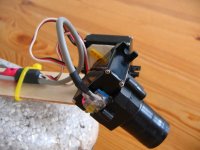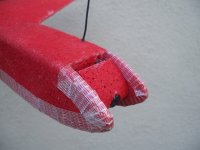Difference between revisions of "Pan Tilt Camera"
| Line 1: | Line 1: | ||
== Pan/Tilt Video Camera Mechanism == | == Pan/Tilt Video Camera Mechanism == | ||
Paparazzi currently allows to automatically move (follow a waypoint) a one axis pitch or roll camera as well as a two axis yaw-fixed-then-pitch camera. | |||
[[Image:Glotzer_cam_xy.jpg|thumb|left|Two axis yaw-fixed, pitch-move mechanism]] | |||
[[Image:Black_one_roll.jpg|thumb|left|One axis roll]] | |||
[[Image:Red_one_pitch.jpg|thumb|left|One axis pitch]] | |||
<br style="clear:both"> | |||
The camera control is made of normal servos. Usually servos have a turn angle of about 90°. This is changed electrically so that they can do a 180°. It is achieved by adding two serial resistors at both sides of the potentiometer (P1), one for increasing the usable angle (R1) and the other for moving the middle position to a useful angle (R2). Therefore a servo with a 270° potentiometer is needed. Very small and light servos have 180° potentiometers, these do not allow a 180° degrees sweep. Cut the outer two connections between the potentiometer and the board to insert the resistors. The values for R1 and R2 should be found out by testing as there might be serial resistors on the servo board that affect the values. Start with about 1/2 the value of P1 for R1 and change R1 until you get a little more than 180° sweep. Then insert and modify R2 to set neutral back to the middle position of the potentiometer. | The camera control is made of normal servos. Usually servos have a turn angle of about 90°. This is changed electrically so that they can do a 180°. It is achieved by adding two serial resistors at both sides of the potentiometer (P1), one for increasing the usable angle (R1) and the other for moving the middle position to a useful angle (R2). Therefore a servo with a 270° potentiometer is needed. Very small and light servos have 180° potentiometers, these do not allow a 180° degrees sweep. Cut the outer two connections between the potentiometer and the board to insert the resistors. The values for R1 and R2 should be found out by testing as there might be serial resistors on the servo board that affect the values. Start with about 1/2 the value of P1 for R1 and change R1 until you get a little more than 180° sweep. Then insert and modify R2 to set neutral back to the middle position of the potentiometer. | ||
<tt> | <tt> | ||
Revision as of 11:32, 1 February 2008
Pan/Tilt Video Camera Mechanism
Paparazzi currently allows to automatically move (follow a waypoint) a one axis pitch or roll camera as well as a two axis yaw-fixed-then-pitch camera.
The camera control is made of normal servos. Usually servos have a turn angle of about 90°. This is changed electrically so that they can do a 180°. It is achieved by adding two serial resistors at both sides of the potentiometer (P1), one for increasing the usable angle (R1) and the other for moving the middle position to a useful angle (R2). Therefore a servo with a 270° potentiometer is needed. Very small and light servos have 180° potentiometers, these do not allow a 180° degrees sweep. Cut the outer two connections between the potentiometer and the board to insert the resistors. The values for R1 and R2 should be found out by testing as there might be serial resistors on the servo board that affect the values. Start with about 1/2 the value of P1 for R1 and change R1 until you get a little more than 180° sweep. Then insert and modify R2 to set neutral back to the middle position of the potentiometer.
^
/
----------
*-------I / I-------*
I ---------- I
I / P1 I
I I I
I I I
--- I ---
I I I I I
I I I I I
I I I I I
--- R1 I --- R2
I I I
I I I
The Paparazzi software makes planes circle clockwise (use negative radius for counter-clockwise) so the default view is to the right side of the plane. The pan servo neutral makes the camera look to the right with 0° given, 90° is to the back and -90° is to the front. The tilt servo neutral makes the camera look down with 0° given, 90° is to the right and -90° is to the left (all values are used in radian in the software). If the camera looks to the right side of the plane, the picture is upright. It is upside down when looking to the left. That is corrected with the MPEG decoding software on the laptop by mirroring. The pan servo is fixed in the plane and the tilt servo is moved by the pan servo and moves the camera.
pan servo, tilt set to 90°, looking from top:
plane front
^
I
I 45°
I /
I/
I------- 0°
I\
I \
I -45°
I
plane rear
tilt servo, pan set to 0°, looking from back:
plane left --------------- plane right
/ I \
/ I \
-45° I 45°
0°
tilt servo is moved by the pan servo and moves the camera.
pan servo, tilt set to 90°, looking from top:
plane front
^
I
I 45°
I /
I/
I------- 0°
I\
I \
I -45°
I
plane rear
tilt servo, pan set to 0°, looking from back:
plane left --------------- plane right
/ I \
/ I \
-45° I 45°
0°


